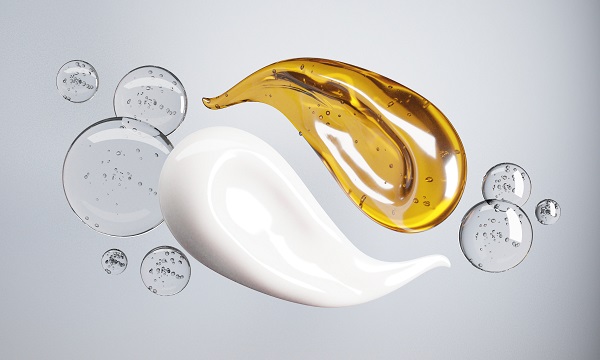ChatGPT said: Exploring the science of emulsifiers in cosmetic applications
Emulsifiers: Secret Active Ingredients for Accomplishing Flawlessly Combined Formulations
Emulsifiers play a necessary duty in developing steady mixtures of immiscible fluids, such as oil and water. Their one-of-a-kind properties enable them to minimize surface stress, which is crucial for uniformity in numerous formulas. Comprehending the differences between natural and artificial emulsifiers can influence item top quality significantly. As markets increasingly seek to enhance structure and shelf life, the choice procedure for the appropriate emulsifier becomes critical. What variables should be considered in this critical choice?
Understanding Emulsifiers: What They Are and Just how They Work
Emulsifiers might appear like a simple addition to formulations, they play an important function in maintaining mixes of components that normally do not mix well, such as oil and water. These compounds work by lowering surface tension at the user interface between immiscible fluids, enabling them to mix more evenly. Emulsifiers have both hydrophilic (water-attracting) and lipophilic (oil-attracting) homes, which allow them to anchor themselves at the limit of both stages. By doing so, they produce a safety obstacle that prevents the beads of one fluid from integrating into larger masses, thereby maintaining a secure solution. The efficiency of an emulsifier depends upon its molecular framework, which affects its capacity to maintain mixes. In various applications, from food to cosmetics, emulsifiers ensure a constant appearance and appearance, boosting both functionality and consumer charm. Their relevance can not be overemphasized in achieving well-blended solutions.
Kinds of Emulsifiers: Natural vs. Synthetic
Emulsifiers can be extensively classified into 2 types: natural and synthetic, each offering distinct advantages and applications. Natural emulsifiers, stemmed from plant or animal resources, include lecithin, casein, and gum tissue arabic (emulsifiers). These emulsifiers are typically preferred in natural and clean-label products because of their marginal handling and biocompatibility. Their mild nature makes them suitable for delicate solutions, particularly in food and cosmetics

On the other hand, artificial emulsifiers such as mono- and diglycerides, and polysorbates are produced through chemical processes. They are frequently utilized in industrial applications as a result of their stability and effectiveness in developing solutions. Synthetic emulsifiers often display premium performance in severe problems, such as heats or differing pH levels. The choice in between natural and synthetic emulsifiers largely depends on the specific formulation needs, governing considerations, and customer choices, affecting their effective application in numerous sectors.
Features of Emulsifiers in Food and Aesthetic Formulations
The function of emulsifiers extends past simple stabilization; they are essential in achieving the preferred look, rack, and structure life of food and cosmetic products. In food solutions, emulsifiers help mix oil and water, developing smooth and consistent textures essential for sauces, dressings, and dairy items. They minimize surface tension, boosting the stability of solutions, which prevents splitting up and extends freshness.
In cosmetics, emulsifiers assure that components, such as oils and water, mix seamlessly, offering an enjoyable feeling and enhancing application. emulsifiers. They add to the product's thickness and spreadability, important for lotions, creams, and serums. Additionally, emulsifiers can encapsulate energetic ingredients, boosting their circulation and efficiency in formulas. By managing texture and enhancing sensory qualities, emulsifiers play a vital duty in meeting customer expectations in both food and cosmetic industries, ensuring items are not only attractive yet additionally functionally efficient
Choosing the Right Emulsifier for Your Product

Additionally, the target application-- whether for food, cosmetics, or pharmaceuticals-- will certainly affect the selection. As an example, food-grade emulsifiers should follow safety regulations, while aesthetic emulsifiers may call for skin compatibility. Evaluating variables such as HLB (Hydrophilic-Lipophilic Balance) assists in forecasting emulsifier habits in specific solutions. Eventually, a complete evaluation of both functional needs and regulative factors to consider is vital to select one of the most reliable emulsifier, making certain the last item fulfills the wanted high quality and stability requirements.

Tips for Effective Emulsion Development and Stability
Accomplishing successful emulsion formation and security needs careful interest to a number of critical variables. The option of emulsifier plays a crucial duty; it ought to be compatible with the oil and water stages to ensure effective stablizing. Second, the ratio of oil to water must be balanced, as an improper proportion can bring about instability. Third, the blending procedure must be regulated; high shear mixing can help achieve smaller bead dimensions, boosting security.
Temperature likewise influences solution security; keeping suitable temperatures during solution avoids early splitting up. Additionally, integrating stabilizers such as thickeners can additionally boost viscosity, minimizing the likelihood of phase splitting up. Carrying out complete security tests after solution will certainly aid recognize possible problems, permitting for modifications before last production. By adhering to these guidelines, formulators can achieve trustworthy and consistent solutions that keep their preferred homes in time.
Frequently Asked Concerns
Can Emulsifiers Be Utilized in Vegan Formulations?
Yes, emulsifiers can be used in vegan formulas. Many plant-based emulsifiers, such as lecithin from soy or sunflower, offer efficient mixing without animal-derived components, making them ideal for a selection of i was reading this vegan items.
What Prevail Allergens in Emulsifiers?
Typical irritants in emulsifiers consist of soy, milk, and eggs, as certain emulsifiers are obtained from these sources. Additionally, some individuals may respond to additives or preservatives utilized together with emulsifiers in various solutions.

Just How Do Emulsifiers Influence Service Life of Products?
Emulsifiers improve item stability by protecting against splitting up of components, thereby extending rack life. They reduce putridity triggered by microbial development and oxidation, bring about long term quality and improved high quality in different food and aesthetic formulations.
Are There Any Type Of Wellness Worries Linked With Emulsifiers?
Research study indicates possible health problems linked with emulsifiers, consisting of digestive tract microbiome alterations and swelling. While regulatory bodies usually regard them safe, recurring research studies remain to check out long-lasting effects on weblink wellness and overall health.
Can Emulsifiers Improve Flavor or Scent in Formulations?
Emulsifiers can boost taste and fragrance in formulas by boosting ingredient dispersion and security. This results in a much more consistent product, enabling tastes to meld successfully, eventually leading to a much more enjoyable sensory experience for consumers.
Emulsifiers might appear like a straightforward enhancement to formulas, they play a crucial role in maintaining mixtures of components that typically do not mix well, such as oil and water. In food formulas, emulsifiers assist blend oil and water, developing smooth and consistent textures vital for sauces, dressings, and dairy items. Food-grade emulsifiers ought to comply with safety Website and security regulations, while aesthetic emulsifiers may need skin compatibility. Typical irritants in emulsifiers consist of soy, dairy, and eggs, as specific emulsifiers are acquired from these sources. Emulsifiers can enhance taste and aroma in formulations by improving ingredient dispersion and security.